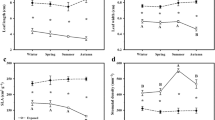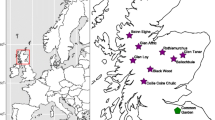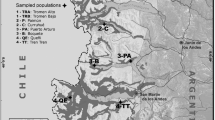Abstract
Chlorophyll pigment concentrations and proportions, nitrogen (N), and needle morphology traits, are important components of growth and were examined in five hybrid index categories from controlled crosses of various crosstypes, ranging from pure black spruce (BS) [Picea mariana (Mill.) B.S.P.] to pure red spruce (RS) (Picea rubens Sarg.) grown under controlled light and water environments. Black spruce had on average 10% greater total chlorophyll concentration (CHL) than RS. Red spruce had proportionately less chlorophyll a:b and CHL:CAR (carotenoid) ratios than BS. Nitrogen (N) concentrations were 1.75 and 1.60% for BS and RS, respectively. Black spruce had the lowest carbon (C):N ratio (29.7) and RS had among the highest (32.3). Interestingly, there was no difference in specific needle area among hybrid indices. Most of the chlorophyll pigment, C and N traits followed an additive inheritance model, evidenced by a near-linear relationship from BS to RS across hybrid indices. However, for CHL, CAR, and CHL:CAR ratio, parental analysis showed significant male effects and non-significant female and male × female interaction effects. Black spruce males had 15.1 and 9.6% higher CHL and CAR, respectively, than hybrid or RS males, thus showing an underlying paternally inherited genetic control. Controlling for N differences, analysis of covariance (ANCOVA) showed that sun-grown seedlings had 22.2% or 300 μg g−1 lower CHL than shade-grown seedlings. Controlling for N, ANCOVA showed that the drought-grown seedlings actually had 6.7% or 100 μg g−1 greater CHL than the irrigated seedlings. Sun plus drought conditions gave the lowest CHL, N, and CHL:CAR ratio of all treatments, showing an additive multi-stress effect. There was a significant hybrid index × light effect as a result of rank changes. Sun-grown RS had the lowest CHL and N values, whereas shade-grown RS had among the highest CHL and N values. Red spruce are at a competitive disadvantage compared with BS and most hybrid spruce in high light, high drought, and high light plus drought conditions. Red spruce will be strongly limited in its distribution by successional opportunities resulting from prevalent harvesting practices such as clearcutting. Silvicultural modifications and genetic restoration will be required to maintain RS on the landscape of northeastern North America.







Similar content being viewed by others
References
Bazzaz FA (1979) The physiological ecology of plant succession. Annu Rev Ecol Syst 10:351–371. doi:10.1146/annurev.es.10.110179.002031
Behera RK, Mishra PC, Choudhury NK (2002) High irradiance and water stress induce alteration in pigment composition and chloroplast activities of primary wheat leaves. J Plant Physiol 159:967–973. doi:10.1078/0176-1617-00823
Beylor J (1999) Management of tolerant softwoods: a provincial perspective from Nova Scotia. In: Harrison G, Whitney R, Swift E (eds) Proceedings of the tolerant softwood workshop. Maritime Forest Ranger School, Fredericton, pp 1–21
Blum BM (1990) Picea rubens Sarg.—red spruce. In: Burns RM, Honkala BH (eds) Silvics of North America, vol 1. Conifers Agricultural Handbook 654. US Department of Agriculture, Forest Service, Washington, DC, pp 250–259
Boardman NK (1977) Comparative photosynthesis of sun and shade plants. Annu Rev Plant Physiol 28:355–377. doi:10.1146/annurev.pp.28.060177.002035
Bobola MS, Eckert RT, Klein AS, Stapelfeldt K, Smith DE, Guenette D (1996) Using nuclear and organelle DNA markers to discriminate among Picea rubens, Picea mariana, and their hybrids. Can J Res 26:433–443. doi:10.1039/cjfr-26-3-433
Brooks JR, Sprugel DG, Hinckley TM (1996) The effects of light acclimation during and after foliage expansion on photosynthesis of Abies amabilis foliage within the canopy. Oecologia 107:21–32. doi:10.1007/BF00582231
Cater TC, Chapin FS III (2000) Differential effects of competition or microenvironment on boreal tree seedling establishment after fire. Ecology 81:1086–1099. doi:10.1890/0012-9658(2000)081[1086:DEOCOM]2.0.CO;2
Chandler JW, Dale JE (1995) Nitrogen deficiency and fertilization effects on needle growth and photosynthesis in Sitka spruce (Picea sitchensis). Tree Physiol 15:813–817
Chapin FS III (1991) Effect of multiple environmental stresses on nutrient availability and use. In: Mooney HA, Winner WE, Pell EJ (eds) Response of plants to multiple stresses. Academic Press, San Diego, pp 67–88
Chapin FS III, Bloom AJ, Field CB, Waring RH (1987) Plant responses to multiple environmental factors. Bioscience 37:49–57. doi:10.2307/1310177
Choudhury NK, Behera RK (2001) Photoinhibition of photosynthesis: role of carotenoids in photoprotection of chloroplasts. Photosynthetica 39:49–57. doi:10.1023/A:1015647708360
Clegg MT, Gaut BS, Learn GH Jr, Morton BR (1994) Rates and patterns of chloroplast DNA evolution. Proc Natl Acad Sci USA 91:6795–6801. doi:10.1073/pnas.91.15.6795
DeHayes DH, Waite CE, Ingle MA, Williams MW (1990) Winter injury susceptibility and cold tolerance of current and year-old needles of red spruce trees from several provenances. For Sci 36:982–994
Demmig-Adams B, Adams WW III (1992) Photoprotection and other responses of plants to high light stress. Ann Rev Plant Physiol Plant Mol Biol 43:599–626. doi:10.1146/annurev.pp.43.060192.003123
Duan B, Lu Y, Yin C, Junttila O, Li C (2005) Physiological responses to drought and shade in two contrasting Picea asperata populations. Physiol Plant 124:476–484. doi:10.1111/j.1399-3054.2005.00535.x
Dumais D, Prévost M (2007) Management for red spruce conservation in Quebec: the importance of some physiological and ecological characteristics—a review. For Chron 83:378–392
Evans JR (1989) Photosynthesis and nitrogen relationships in leaves of C3 plants. Oecologia 78:9–19. doi:10.1007/BF00377192
Fisk MC, Zak DR, Crow TR (2002) Nitrogen storage and cycling in old- and second-growth northern hardwood forests. Ecology 83:73–87. doi:10.1890/0012-9658(2002)083[0073:NSACIO]2.0.CO;2
Fraver S, White AS (2005) Disturbance dynamics of old-growth Picea rubens forests of northern Maine. J Veg Sci 16:597–610. doi:10.1658/1100-9233(2005)16[597:OOOOPR]2.0.CO;2
Gordon AG (1976) The taxonomy and genetics of Picea rubens and its relationship to Picea mariana. Can J Bot 54:781–813. doi:10.1139/cjb-54-9-781
Gordon AG (1996) The sweep of the boreal in time and space, from forest formation to genes, and implications for management. For Chron 72:19–30
Grassi G, Vicinelli E, Ponti F, Cantoni L, Magnani F (2005) Seasonal and interannual variability of photosynthetic capacity in relation to leaf nitrogen in a deciduous leaf forest plantation in northern Italy. Tree Physiol 25:349–360
Gratani L, Ghia E (2002) Changes in morphological and physiological traits during leaf expansion of Arbutus unedo. Environ Exp Bot 48:51–60. doi:10.1016/S0098-8472(02)00010-2
Grossnickle SC (2000) Ecophysiology of northern spruce species: the performance of planted seedlings. NRC Research Press, Ottawa
Guo D-P, Guo Y-P, Zhao J-P, Liu H, Peng Y, Wang Q-M, Chen J-S, Rao G-Z (2005) Photosynthetic rate and chlorophyll fluorescence in leaves of stem mustard (Brassica juncea var. tsatsai) after turnip mosaic virus infection. Plant Sci 168:57–63. doi:10.1016/j.plantsci.2004.07.019
Hamburg SP, Cogbill CV (1988) Historical decline of red spruce populations and climate warming. Nature 331:428–431. doi:10.1038/331428a0
Johnsen KH, Major JE Loo, McPhee D (1998) Negative heterosis not apparent in 22-year-old hybrids of Picea mariana and Picea rubens. Can J Bot 76:434–439. doi:10.1139/cjb-76-3-434
Khan SR, Rose R, Haase DL, Sabin TE (2000) Effects of shade on morphology, chlorophyll concentration, and chlorophyll fluorescence of four Pacific Northwest conifer species. New For 19:171–186. doi:10.1023/A:1006645632023
Korstian CF (1937) Perpetuation of spruce on cut-over and burned lands in the higher southern Appalachian Mountains. Ecol Monogr 7:126–167. doi:10.2307/1943304
Kramer PJ, Kozlowski Y (1979) Physiology of wood plants. Academic Press, New York
Kronfuss G, Polle A, Tausz M, Havranek WM, Wieser G (1998) Effects of ozone and mild drought stress on gas exchange, antioxidants and chloroplast pigments in current-year needles of young Norway spruce [Picea abies (L.) Karst]. Trees 12:482–489. doi:10.1007/PL00009730
Lazarus BE, Schaberg PG, DeHayes DH, Hawley GJ (2004) Severe red spruce winter injury in 2003 creates unusual ecological event in the northeastern United States. Can J For Res 34:1784–1788. doi:10.1139/x04-122
Lichtenthaler HK (1987) Chlorophylls and carotenoids: pigments of photosynthetic biomembranes. Methods Enzymol 148:350–382. doi:10.1016/0076-6879(87)48036-1
Major JE, Johnsen KH (1996) Family variation in photosynthesis of 22-year-old black spruce: a test of two models of physiological response to water stress. Can J For Res 26:1922–1933. doi:10.1139/cjfr-26-11-1922
Major JE, Barsi DC, Mosseler A, Campbell M, Rajora OP (2003a) Light-energy processing and freezing-tolerance traits in red spruce and black spruce: species and seed-source variation. Tree Physiol 23:685–694
Major JE, Mosseler A, Barsi DC, Campbell M, Rajora OP (2003b) Morphometric allometric, and developmentally adaptive traits in red spruce and black spruce. I. Species and seed source variation. Can J For Res 33:885–896. doi:10.1139/x03-049
Major JE, Mosseler A, Barsi DC, Campbell M, Rajora OP (2003c) Morphometric, allometric, and developmentally adaptive traits in red spruce and black spruce. II. Seedling and mature tree assessment of controlled intra- and inter-specific hybrids. Can J For Res 33:897–909. doi:10.1139/x03-067
Major JE, Mosseler A, Johnsen KH, Rajora OP, Barsi DC, Kim K-H, Park J-M, Campbell M (2005) Reproductive barriers and hybridity in two spruces, Picea rubens and Picea mariana, sympatric in eastern North America. Can J Bot 83:163–175. doi:10.1139/b04-161
Major JE, Barsi DC, Mosseler A, Campbell M (2007a) Genetic variation and control of chloroplast pigment contentrations in Picea rubens, Picea mariana, and their hybrids. I. Ambient and elevated CO2 environments. Tree Physiol 27:353–364
Major JE, Barsi DC, Mosseler A, Rajora OP, Campbell M (2007b) Predominant paternal inheritance pattern of light-energy processing adaptive traits in red and black spruce hybrids. Can J For Res 37:293–305. doi:10.1139/x06-228
Major JE, Mosseler A, Barsi DC, Campbell M (2007c) Comparative nutrient economy, stable isotopes and related adaptive traits in Picea rubens, Picea mariana, and their hybrids. Trees (Berl) 21:677–692. doi:10.1007/s0046-007-0161-z
Malavasi UC, Malavasi MM (2001) Leaf characteristics and chlorophyll concentration of Schyzolobium parahybum and Hymenaea stilbocarpa seedlings grown in different light regimes. Tree Physiol 21:701–703
Manley SAM (1971) Identification of red, black, and hybrid spruces. Natural Resources Canada, Canadian Forest Service Publ. No. 1301, Ottawa
Manley SAM (1975) Genecology of hybridization in red spruce (Picea rubens Sarg.) and black spruce (Picea mariana (Mill.) BSP.) PhD dissertation. Yale University, New Haven
Manley SAM, Ledig FT (1979) Photosynthesis in black and red spruce and their hybrid derivatives: ecological isolation and hybrid adaptive inferiority. Can J Bot 57:305–314. doi:10.1139/cjb-57-4-305
Maslova TG, Popova IA (1993) Adaptive properties of the plant pigment systems. Photosynthetica 29:195–203
McLaughlin SB, Downing DJ, Blasing TJ, Cook ER, Adams HS (1987) An analysis of climate and competition as contributors to the decline of red spruce in high elevation Appalachian forests of the eastern United States. Oecologia 72:487–501. doi:10.1007/BF00378973
Meziane D, Shipley B (2001) Direct and indirect relationships between specific leaf area, leaf nitrogen and leaf gas exchange. Effects of irradiance and nutrient supply. Ann Bot (Lond) 88:915–927. doi:10.1006/anbo.2001.1536
Morgenstern EK, Farrar JL (1964) Introgressive hybridization in red and black spruce. University of Toronto, Faculty of Forestry Technical Report 4
Mosseler A, Major JE, Simpson JD, Daigle B, Lange K, Park Y-S, Johnsen KJ, Rajora OP (2000) Indicators of population viability in red spruce, Picea rubens: I. Reproductive traits and fecundity. Can J Bot 78:928–940. doi:10.1139/cjb-78-7-928
Mosseler A, Major JE, Rajora OP (2003) Old-growth red spruce forests as reservoirs of genetic diversity and reproductive fitness. Theor Appl Genet 106:931–937. doi:10.1007/s00122-002-1156-1
Munné-Bosch S, Alegre L (2000) The significance of β-carotene, α-tocopherol and the xanthophyll cycle in droughted Melissa officinalis plants. Aust J Plant Physiol 27:139–146. doi:10.1071/pp99107
Nelson VL, Gjerstad DH, Glover GR (1986) Determining nitrogen status of young loblolly pine by leaf reflectance. Tree Physiol 1:333–339
New Brunswick Department of Natural Resources and Energy (1999) Silviculture statistics. Crown lands 1998–99. Technical Report 99–03, NBDNR, Fredericton
Niinemets U, Ellsworth DS, Lukjanova A, Tobias M (2002) Dependence of needle architecture and chemical composition on canopy light availability in three North American Pinus species with contrasting needle length. Tree Physiol 22:747–761
Olivas-Garcia JM, Cregg DM, Hennessey TC (2000) Genotypic variation in carbon isotope driscrimination and gas exchange of ponderosa pine seedlings under two levels of water stress. Can J For Res 30:1581–1590. doi:10.1139/cjfr-30-10-1581
Palmer JD (1985) Comparative organization of chloroplast genomes. Ann Rev Genet 19:325–354. doi:10.1146/annurev.ge.19.120185.001545
Panek JA (2004) Ozone uptake, water loss and carbon exchange dynamics in annually drought-stressed Pinus ponderosa forests: measured trends and parameters for uptake modeling. Tree Physiol 24:277–290
Parker WC, Colombo SJ, Cherry ML, Flannigan MD, Greifenhagen S, McAlpine RS, Papadopol C, Scarr T (2000) Third millennium forestry: What climate change might mean to forests and forest management in Ontario. For Chron 76:445–461
Peters RL (1990) Effects of global warming on forests. For Ecol Manage 35:13–33. doi:10.1016/0378-1127(90)90229-5
Petit RJ, Pineau E, Demesure B, Bacilier R, Ducousso A, Kremer A (1997) Chloroplast DNA footprints of postglacial recolonization by oaks. Proc Natl Acad Sci USA 94:9996–10001. doi:10.1073/pnas.94.18.9996
Proietti P (2003) Changes in photosynthesis and fruit characteristics in olive in response to assimilate availability. Photosynthetica 41:559–564. doi:10.1023/B:PHOT.0000027520.12822.de
Richardson AD (2004) Foliar chemistry of balsam fir and red spruce in relation to elevation and canopy light gradient in the mountains of the Northeastern United States. Plant Soil 260:291–299. doi:10.1023/B:PLSO.0000030179.02819.85
Ripullone F, Grassi G, Lauteri M, Borghetti M (2003) Photosynthesis-nitrogen relationships: interpretation of different patterns between Pseudotsuga menziesii and Populus × euroamericana in a mini-stand experiment. Tree Physiol 23:137–144
Robakowski P, Montpied P, Dreyer E (2003) Plasticity of morphological and physiological treaits in response to different levels of irradiance in seedlings of silver fir (Abies alba Mill). Trees (Berl) 17:431–441. doi:10.1007/s00468-003-0257-z
Rosevear MJ, Young AJ, Johnson GN (2001) Growth conditions are more important than species origin in determining leaf pigment content of British plant species. Funct Ecol 15:474–480. doi:10.1046/j.0269-8463.2001.00540.x
Ryan MG, Yoder BJ (1997) Hydraulic limits to tree height and tree growth. Bioscience 47:235–242. doi:10.2307/1313077
Samuelson LJ, Seiler JR (1994) Red spruce seedling gas exchange in response to elevated CO2, water stress and soil fertility treatments. Can J For Res 24:954–959. doi:10.1139/cjfr-245-954
Stenberg P, Smolander H, Sprugel D, Smolander S (1998) Shoot structure, light interception, and distribution of nitrogen in an Abies amabilis canopy. Tree Physiol 18:759–767
Stenberg P, Palmroth S, Bond BJ, Sprugel DG, Smolander H (2001) Shoot structure and photosynthetic efficiency along the light gradient in Scots pine canopy. Tree Physiol 21:805–814
Sutton BCS, Flanagan DJ, Gawley JR, Newton CH, Lester DT, El-Kassaby YA (1991) Inheritance of chloroplast and mitochondrial DNA in Picea and composition of hybrids from introgression zones. Theor Appl Genet 82:242–248. doi:10.1007/BF00226220
Taiz L, Zeiger E (1997) Plant Physiology. The Benjamin/Cummings Publishing Company Inc., Redwood City
Tausz M, Wonisch A, Peters J, Jimenez MS, Morales D, Grill D (2001) Short term changes in free radical scavengers and chloroplast pigments in Pinus canariensis needles as affected by drought stress. J Plant Physiol 158:213–219. doi:10.1078/0176-1617-00178
Viereck LA, Johnston WF (1990) Picea mariana (Mill.) B.S.P.—black spruce. In: Burns RM, Honkala BH (eds) Silvics of North America, vol 1, Conifers. US Dept Agric, For Serv, Agriculture Handbook 654, Washington, pp 227–237
Yardonov I, Velikova V, Tsonev T (2000) Plant responses to drought, acclimation and stress tolerance. Photosynthetica 28:171–186. doi:10.1023/A:1007201411474
Yoder BJ, Ryan MG, Waring RH, Schoettle AW, Kaufmann MR (1994) Evidence of reduced photosynthetic rates in old trees. For Sci 40:513–527
Yoo SD, Greer DH, Laing WA, MacManus MT (2003) Changes in photosynthetic efficiency and carotenoid composition in leaves of white clover at different developmental stages. Plant Physiol Biochem 41:887–893. doi:10.1016/s0981-9481(03)00138-4
Acknowledgments
We gratefully acknowledge useful comments received from Drs. Tannis Beardmore and Judy Loo. In addition, the greenhouse and nursery growing skills of Laurie Yeates and Terry Hay and technical skills of Cindy Henderson, Stephanie West, and Peter Tucker are thankfully acknowledged.
Author information
Authors and Affiliations
Corresponding author
Additional information
Communicated by J. E. Carlson.
Rights and permissions
About this article
Cite this article
Barsi, D.C., Major, J.E., Mosseler, A. et al. Genetic variation and control of chloroplast pigment concentrations and related needle-level traits in Picea rubens, Picea mariana, and their hybrids: moisture and light environmental effects. Trees 23, 555–571 (2009). https://doi.org/10.1007/s00468-008-0301-0
Received:
Revised:
Accepted:
Published:
Issue Date:
DOI: https://doi.org/10.1007/s00468-008-0301-0




